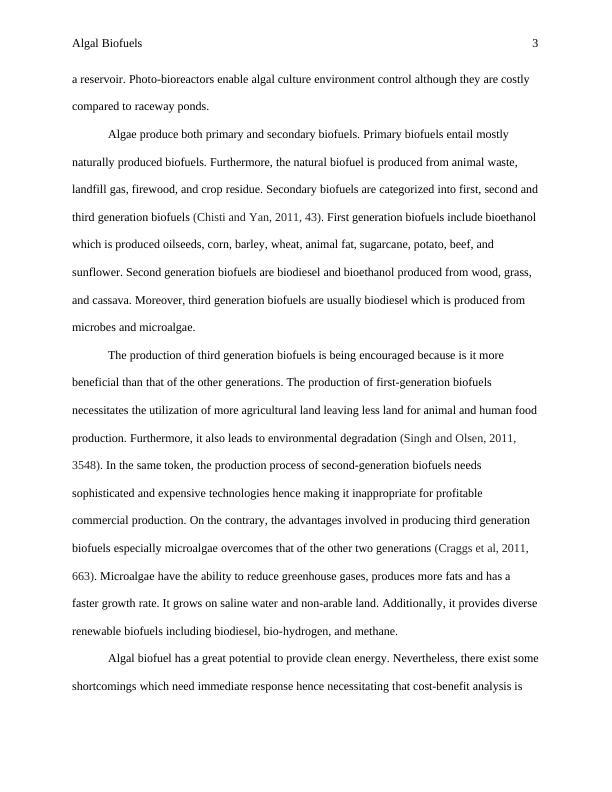Ask a question from expert
Environmental Biotechnology - PDF
6 Pages1437 Words191 Views
Added on 2021-05-31
Environmental Biotechnology - PDF
Added on 2021-05-31
BookmarkShareRelated Documents
Algal Biofuels 1Student NameEnvironmental BiotechnologyAlgal BiofuelsInstructorUniversityDate

Algal Biofuels 2Algal biofuel is basically a substitute for liquefied fossil fuels which utilizes algae. It is important to note that the algae produces oils which are rich in energy. Algal oils are alternatives to the ordinary biofuel sources, for instance, sugarcane and corn. Algae fuel similar to fossil fuel usually release carbon dioxide when they are burnt. On the other hand, algae fuel in comparison to fossil fuel releases carbon dioxide into the atmosphere which has been recently removed. Additionally, this is done through photosynthesis mostly as the algae grow. The growth of algae fuel is simple and more so advantageous (Georgianna and Mayfield, 2012, 329). Algae growth does not contaminate freshwater sources. It is less harmful to the environment and is producible using waste or saline water. There are different chemical processes involved in the production of algal biofuels. Different organic solvents are utilized in extracting lipids. Chloroform and methanol are utilized in extracting oils from algae. The use of the chemicals is still utilized in estimating algal oils spectrophotometrically. It is easy and faster to use the chemicals, especially when handling a wide variety of samples (Georgianna and Mayfield, 2012, 329). Likewise, adding some acetic acid during the extraction process leads to extraction of more acidic phospholipids. Consequently, other chemical solvents such as butanol, isopropanol, ethanol, and hexane are essential in the production of algal biofuels. Algal biofuels are produced using two methods namely photo-bioreactors and raceway pond method. A raceway pond is an oval loop which is about 0.5m deep. It is well aerated and has a wheel that circulates water hence preventing sedimentation. Raceway ponds are usually shallow because self-shading and optical absorption by algal cells hinder penetration of light through the algal broth (Singh, Nigam and Murphy, 2011, 329). In photo-bioreactors, a culture medium is basically contained in transparent plates. The micro-algal broth is then circulated from

Algal Biofuels 3a reservoir. Photo-bioreactors enable algal culture environment control although they are costly compared to raceway ponds. Algae produce both primary and secondary biofuels. Primary biofuels entail mostly naturally produced biofuels. Furthermore, the natural biofuel is produced from animal waste, landfill gas, firewood, and crop residue. Secondary biofuels are categorized into first, second andthird generation biofuels (Chisti and Yan, 2011, 43). First generation biofuels include bioethanol which is produced oilseeds, corn, barley, wheat, animal fat, sugarcane, potato, beef, and sunflower. Second generation biofuels are biodiesel and bioethanol produced from wood, grass, and cassava. Moreover, third generation biofuels are usually biodiesel which is produced from microbes and microalgae. The production of third generation biofuels is being encouraged because is it more beneficial than that of the other generations. The production of first-generation biofuels necessitates the utilization of more agricultural land leaving less land for animal and human foodproduction. Furthermore, it also leads to environmental degradation (Singh and Olsen, 2011, 3548). In the same token, the production process of second-generation biofuels needs sophisticated and expensive technologies hence making it inappropriate for profitable commercial production. On the contrary, the advantages involved in producing third generation biofuels especially microalgae overcomes that of the other two generations (Craggs et al, 2011, 663). Microalgae have the ability to reduce greenhouse gases, produces more fats and has a faster growth rate. It grows on saline water and non-arable land. Additionally, it provides diverserenewable biofuels including biodiesel, bio-hydrogen, and methane. Algal biofuel has a great potential to provide clean energy. Nevertheless, there exist someshortcomings which need immediate response hence necessitating that cost-benefit analysis is

End of preview
Want to access all the pages? Upload your documents or become a member.
Related Documents
Converting Vegetable oil using CO2 as reactant into Aviation Fuel or Biofuellg...
|9
|1558
|144